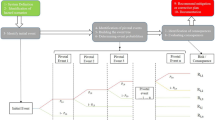Abstract
The construction of floating nuclear power plants began in the interests of supplying energy in remote far-north and far-east regions in our country which are difficult to reach. A predictive assessment of radiological and radioecological consequences of operating such plants is extremely urgent. The problem is examined on the basis of the effects of a floating nuclear power plant on plant workers, the public, and the environment that have been determined by a computational method at the design stage as well as on the basis of generalization and analysis of experience gained in operating nuclear powered ships under the difficult climatic conditions in the Far North and Far East over the last 45 years.
Similar content being viewed by others
References
F. M. Mitenkov and V. I. Polunichev, “Small nuclear heat and power co-generation stations and water desalination complexes on the basis of marine reactor plants,” Nucl. Eng. Design, No. 173, 183–191 (1997).
V. I. Makarov, B. G. Pologikh, N. S. Khlopkin, et al., “Experience in developing and operating reactor systems for civilian ships,” At. Énerg., 89, No. 3, 179–189 (2000).
V. I. Makarov and N. S. Khlopkin, “On power systems for new-generation icebreakers,” Sudostr., No. 1, 21–26 (2005).
Radiation Safety Standards (NRB-99), Hygienic Norms, Center for Sanitary-Epidemiological Standardization, Hygienic Certification, and Expert Analyses of the Russian Ministry of Health, Moscow (1999).
Sanitary Rules for Design and Operation of Nuclear Power Plants (SP AS-03). Rules for Radiologically Safe Operation of Nuclear Power Plants (PRB As-99), Moscow (2000).
Report on the Scientific and Technical Problems of Salvaging Objects of the Nuclear Powered Icebreaking Fleet and Handling Spent Nuclear Fuel and Radwastes Formed During the Operation of the Fleet, Russian Science Center Kurchatov Institute, Moscow (2004).
Low-Capacity Nuclear Heat and Electric Power Plant Based on a Floating Power Generating Unit with KLT-40S Reactor Systems (Handling Radwastes), TsKB Aisberg OAO, St. Petersburg (2001).
Guide for Establishing Admissible Emissions of Radioactive Substances into the Atmosphere, DV-98, Ministry of Atomic Energy of the Russian Federation, Moscow (1999).
International Basic Safety Standards for Protection Against Ionizing Radiation and for the Safety of Radiation Sources, Safety Series No. 115, IAEA, Vienna (1996).
K. Eckerman and J. Ryman, External Exposure to Radionuclides in Air, Water, and Soil, Report EPA.402.R.93.081, Washington (1993).
Methods for Calculating the Propagation of Radioactive Substances from Nuclear Power Plants and Irradiation of the Surrounding Population, NTD 38.220.56-84, Vol. 1, Part 1, MKhO Interatoménergo, Énergoatomizdat, Moscow (1984).
V. I. Makarov, B. G. Pologikh, N. S. Khlopkin, et al., “Experience in developing and operating reactor systems for civilian ships,” At. Énerg., 89, No. 3, 179–189 (2000).
V. V. Dovgusha, I. F. Zhil’tsov, B. N. Raevskii, et al., “Medical aspects of radiological and ecological safety of nuclear powered ships,” Yad. Obshch. Rossii (1995), pp. 235–243.
G. G. Matishov, “Radionuclides and oceanographic conditions of their accumulation in Kol’skii and Motovskii zalivs,” Preprint MMBI, Murmansk (1997).
Facts and Problems Associated with Disposal of Radwastes in the Seas Bordering the Territory of the Russian Federation, Report of a Government Commission for Sea Disposal of Radioactive Wastes, Created by an Order of the President of the Russian Federation, October 24, 992, No 613-rp, Moscow (1993).
Yu. V. Sivintsev, S. M. Vakulovskii, A. P. Vasil’ev, V. L. Vysotskii, et al., Technogenic Radionuclides in the Seas Bordering Russia. Radioecological Consequences of Disposal of Radioactive Wastes in Arctic and Far East Seas, White Book-2000, IzdAT, Moscow (2005).
Radioactive Contamination and Dumping Sites for Nuclear Waste in the Kara Sea. Results from the Russian-Norwegian 1993 Expedition to the Kara Sea, Joint Russian-Norwegian Expert Group (JRNG) for Investigation of Radioactive Contamination in the Northern Areas, Osteras, Norwegian Radiation Protection Authority (1994).
Predicted Radionuclide Release from Marine Reactors Dumped in the Kara Sea, IAEA-TECDOC-938, IAEA, Vienna (1997).
V. L. Vysotskii, V. S. Nikitin, V. A. Danilyan, et al., “Effect of salvaging of submarines on the radioecological conditions at Severodvinsk,” At. Énerg., 92, No. 5, 396–414 (2002).
V. A. Danilyan, V. L. Vysotskii, A. A. Maksimov, and Yu. V. Sivintsev, “Effect of salvaging the nuclear submarines on the radioecological conditions in the Far East,” At. Énerg., 89, No. 6, 454–474 (2000).
Guide for Monitoring Radioactive Contamination of the Environment and Internal Irradiation of the Crews on Ships with Nuclear Power Systems, Voenizdat, Moscow (1991).
E. L. Chaikovskaya, V. L. Vysotskii, and D. V. Gichev, “Mechanisms of the formation of radiation conditions on the territory of Primorskii krai,” At. Énerg., 91, No. 3, 223–237 (2001).
Radiological Legacy of the Cold War, Ros. Zelenyi Krest, Moscow (1999).
Author information
Authors and Affiliations
Additional information
__________
Translated from Atomnaya Énergiya, Vol. 104, No. 3, 178–187, March, 2008.
Rights and permissions
About this article
Cite this article
Sarkisov, A.A., Vysotskii, V.L., Bilashenko, V.P. et al. Expected radiological and radioecological consequences of operating floating nuclear heat and power plants. At Energy 104, 237–249 (2008). https://doi.org/10.1007/s10512-008-9022-0
Received:
Published:
Issue Date:
DOI: https://doi.org/10.1007/s10512-008-9022-0




